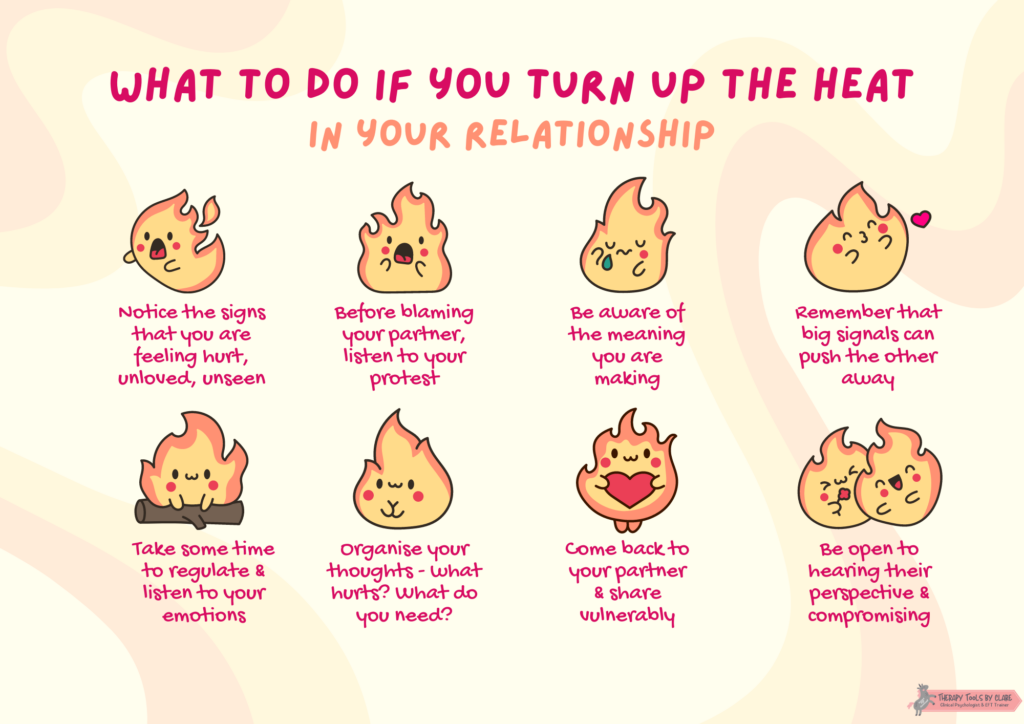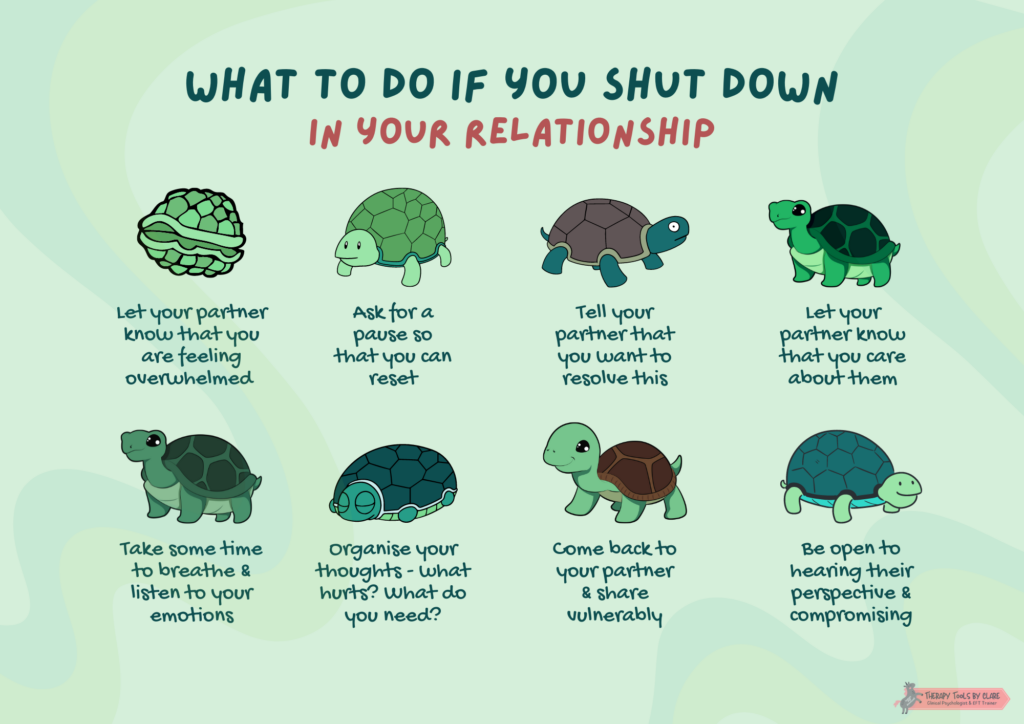Turning up the heat and sutting down in a relationship through the attachment lens in EFT

In emotionally focused therapy (EFT), attachment styles such as anxious-ambivalent and avoidant are key to understanding how individuals relate to one another, especially in close relationships. EFT is grounded in attachment theory, which posits that human bonds, particularly those in intimate relationships, provide a foundation for emotional security. The attachment styles we develop in childhood profoundly shape how we connect and engage in relationships as adults.
Anxious-ambivalent attachment style
Anxious-ambivalent attachment in EFT is viewed as a result of inconsistent caregiving, where the individual experienced unreliable emotional support from caregivers—sometimes available, sometimes absent. In adulthood, when entering relationships, they take the position of the Pursuing partners, their strategies for coping with relationships revolve around a constant fear of abandonment and a need for reassurance. Here are the key strategies they tend to employ:
People with this attachment style tend to exhibit the following behaviors:
1. Intense Need for Pursuing Closeness and Dependence: Individuals with an anxious-ambivalent attachment style desire deep emotional intimacy but are often plagued by fear that their partner may reject or abandon them. In EFT, this craving for closeness is seen as driven by insecurity and uncertainty about whether their emotional needs will be met.
2. Fear of Abandonment: These individuals are highly sensitive to signs of emotional distance or potential rejection. EFT recognizes that even small actions, like a delayed response from their partner, can trigger intense fear and anxiety that they are being neglected. As a result, they often seek constant reassurance or engage in behaviors that try to control the relationship to ensure emotional security.
3. Constant Need for Reassurance: Individuals with an anxious-ambivalent style often require ongoing validation from their partner. They seek frequent affirmations of love and commitment, as any perceived distance or lack of attention can trigger deep feelings of insecurity and fear.
4. Emotional Swings: These individuals are prone to emotional highs and lows in relationships. They may feel euphoric when they sense closeness, but small signs of emotional distance can quickly plunge them into feelings of despair, frustration, or anger.
5. Controlling Behaviors: To ward off the fear of abandonment, they may resort to controlling tactics, such as constantly checking in on their partner, demanding attention, or engaging in behaviors designed to maintain closeness.
6. Idealization and Devaluation of Partners: In relationships, they may alternately idealize their partner, seeing them as the key to their happiness, and then devalue them when they feel emotionally neglected. This pattern can create instability, as they swing between adoration and dissatisfaction.
7. Emotional Reactivity: When feeling threatened, anxious-ambivalent individuals may react with intense emotional outbursts. Whether through anger, tears, or dramatic expressions of hurt, they often resort to heightened emotional displays as a way to elicit reassurance or re-establish closeness.
In summary, individuals with an anxious-ambivalent attachment style have a deep need for love and closeness, but their insecurity and fear of rejection often make relationships unstable and full of tension. Their strategies aim to ensure emotional security, but paradoxically, they can lead to strain in the relationship and make it difficult to maintain.
In EFT therapy it is often observed that Pursuing partners are often caught in cycles of emotional escalation. They may respond with intense emotions to perceived signs of neglect, seeking to provoke a reaction that reassures them of their partner’s love and commitment. However, these emotional outbursts can overwhelm their partner, often leading to further emotional withdrawal.
If you identify with this attachment style, here are some tips on what to do when you turn up the heat in your relationship:

If you’d like an A4 copy you can download it HERE.
And HERE you will find A Love Letter to Pursuers, which can help you understand a person with an anxious-ambivalent attachment style even more.
Avoidant Attachment style
Avoidant Attachment in EFT, on the other hand, is understood as a protective strategy developed in response to emotionally unavailable caregivers during childhood. Individuals with this attachment style learned to rely on themselves and suppress their emotional needs, as turning to caregivers often resulted in disappointment. Their strategies for navigating relationships are deeply rooted in a desire to maintain independence and avoid vulnerability. In adult relationships they take the position of the Withdrawing partners, typically exhibiting the following traits:
1. Avoidance of Emotional Closeness: People with avoidant attachment tend to keep emotional distance, as they associate closeness with a loss of autonomy or the risk of emotional pain. In EFT, this avoidance is seen as a defense mechanism—a way to protect themselves from potential rejection or vulnerability.
2. Strong Emphasis on Independence: Avoidantly attached individuals often prioritize independence and self-reliance, making it difficult for them to form deep emotional connections. This pursuit of autonomy is a way to avoid confronting emotional needs that were minimized or ignored in childhood.
3. Suppressing Emotions: Avoidantly attached individuals tend to downplay both their own and others’ emotions. Emotional self-expression may be uncomfortable for them, so they focus on logic and reasoning rather than emotion.
4. Withdrawal in Conflict: When faced with conflict or tension in relationships, avoidant individuals are likely to withdraw rather than engage. They may disengage from difficult conversations or pull away emotionally, using avoidance as a way to protect themselves from the discomfort of emotional confrontation.
5. Focusing on Career or Personal Goals: Avoidantly attached people often channel their energy into work, hobbies, or personal achievements. By focusing on external goals, they can sidestep the emotional demands of close relationships, finding fulfillment in areas where they feel more in control.
6. Difficulty with Commitment: Commitment in relationships can feel daunting for avoidant individuals, as it may be associated with a loss of freedom or independence. They often struggle with long-term commitments and may withdraw from relationships once they become too emotionally demanding or intense.
7. Idealizing Distant Relationships: These individuals may idealize romantic partners from a distance, but as soon as a relationship becomes too intimate, they might focus on flaws or reasons to withdraw. This cycle helps them maintain their emotional detachment while avoiding true vulnerability.
These strategies serve as protective mechanisms that help avoidant individuals cope with their fear of emotional closeness and dependence. However, these same behaviors often hinder their ability to build fulfilling and meaningful relationships. When faced with conflict, avoidantly attached individuals are likely to withdraw emotionally rather than engage in difficult conversations. EFT views this withdrawal as a strategy to avoid confronting emotions, which ultimately creates more distance in the relationship. For their partner, this behavior can feel like emotional neglect, leading to increasing tension and frustration. Understanding these patterns is crucial in therapy, as it can help Withdrawing partners move toward healthier, more secure ways of connecting with others.
If you identify with this attachment style, here are some tips on what to do when you shutting down in your relationship:

If you’d like an A4 copy you can download it HERE.
And HERE you will find A Love Letter to Withdrawers, which can help you understand a person with an avoidant attachment style even more.
Interaction Cycles
In EFT, these two attachment styles can create destructive interaction cycles. For example, a person with an anxious-ambivalent attachment style may seek greater closeness and reassurance, which can overwhelm someone with an avoidant attachment style, causing them to withdraw further. This, in turn, intensifies the anxiety of the anxious partner, creating a negative feedback loop of emotional distance and frustration. You can read more about the EFT Infinity Loop HERE.
EFT and Working with Attachment Styles
The goal of EFT is to help couples break these negative cycles by creating a safe space for both partners to understand and express their emotional needs. For individuals with an anxious-ambivalent attachment, EFT helps them learn to express their needs in a way that is less reactive and more direct. For those with an avoidant attachment style, EFT encourages them to become more open to emotional vulnerability and intimacy. Through this process, both partners can develop a more secure, stable, and emotionally fulfilling connection.
All graphics used in this post were created by Clare Rosoman, a certified EFT trainer from Australia. Both Love Letters to Pursuers and Withdrawers were written by Kelly Bourque, a certified by ICEEFT EFT Therapist and Supervisor. Clare and Kelly allowed Barbara Sławik, a certified EFT supervisor, to translate them into the local language for the Polish community. We hope they are helpful 🤩
October 3rd 2024
text: Barbara Sławik picture: niloy tesla
ways to help
for therapists
mentalia
mentalia.pl is owned by
„Mental Breathes” Barbara Sławik
ul. Wałbrzyska 48/11
02-739 Warszawa
Privacy Policy
Information clause on processing of personal data


